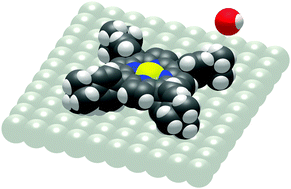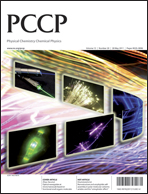The molecular interaction of dihydroxo[5,10,15,20-tetrakis(4-tert-butyl-phenyl)porphyrinato]-tin(IV) (SnTTBPP(OH)2), the structural order and growth of ultrathin films on Ag(100) have been studied by means of low-energy electron diffraction (LEED) and synchrotron based photoelectron spectroscopy, i.e., X-ray photoemission (XPS) and near-edge X-ray absorption fine structure (NEXAFS/XANES) spectroscopy. For the first time, monolayer adsorption of a metalloporphyrin with octahedral coordination of the metal center by two additional axial hydroxo ligands is investigated in a multi-technique study. The delicate balance of molecule–substrate interactions and intermolecular interactions leads to the formation of a densely-packed organic monolayer which is commensurate with the Ag(100) substrate. From NEXAFS linear dichroism an almost coplanar orientation of the porphyrin system is derived. XPS and NEXAFS clearly indicate that the axial hydroxo ligands are cleaved in monolayer films, i.e., upon adsorption to the Ag substrate. With increasing film thickness orientational order gets lost and leads to polycrystalline growth for thicker films as confirmed by scanning X-ray transmission microscopy (STXM).

You have access to this article
 Please wait while we load your content...
Something went wrong. Try again?
Please wait while we load your content...
Something went wrong. Try again?


 Please wait while we load your content...
Please wait while we load your content...